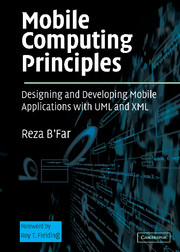Book contents
- Frontmatter
- Contents
- Foreword by Roy T. Fielding
- Acknowledgments
- SECTION 1 INTRODUCTIONS TO THE MAIN TOPICS
- SECTION 2 DEVICE-INDEPENDENT AND MULTICHANNEL USER INTERFACE DEVELOPMENT USING UML
- SECTION 3 ADDITIONAL DIMENSIONS OF MOBILE APPLICATION DEVELOPMENT
- Chapter 9 Mobile Agents and Peer-to-Peer Architectures for Mobile Applications
- Chapter 10 Wireless Connectivity and Mobile Applications
- Chapter 11 Synchronization and Replication of Mobile Data
- Chapter 12 Mobility and Location-Based Services
- Chapter 13 Active Transactions
- Chapter 14 Mobile Security
- SECTION 4 PUTTING THE PROJECT TOGETHER
- References
- Index
Chapter 9 - Mobile Agents and Peer-to-Peer Architectures for Mobile Applications
from SECTION 3 - ADDITIONAL DIMENSIONS OF MOBILE APPLICATION DEVELOPMENT
Published online by Cambridge University Press: 03 September 2009
- Frontmatter
- Contents
- Foreword by Roy T. Fielding
- Acknowledgments
- SECTION 1 INTRODUCTIONS TO THE MAIN TOPICS
- SECTION 2 DEVICE-INDEPENDENT AND MULTICHANNEL USER INTERFACE DEVELOPMENT USING UML
- SECTION 3 ADDITIONAL DIMENSIONS OF MOBILE APPLICATION DEVELOPMENT
- Chapter 9 Mobile Agents and Peer-to-Peer Architectures for Mobile Applications
- Chapter 10 Wireless Connectivity and Mobile Applications
- Chapter 11 Synchronization and Replication of Mobile Data
- Chapter 12 Mobility and Location-Based Services
- Chapter 13 Active Transactions
- Chapter 14 Mobile Security
- SECTION 4 PUTTING THE PROJECT TOGETHER
- References
- Index
Summary
To the “Drive” and No. 7
INTRODUCTION
In Chapter 16, we briefly look at five different architecture types: fully centralized, client–server and its variations of N-tier, mobile agents, and peer-to-peer. You may want to refer to this chapter intermittently or read it first. In this chapter, we will focus on the latter two, namely mobile agents and peer-to-peer systems, as relating to mobile application development.
We focus on these systems for two reasons. First, the application of mobile agents and peer-to-peer architectures in the mobile application realm is not well documented because both are fairly recent concepts. Second, both mobile agents and peer-to-peer architectures promise to play an integral role in mobile application development as it matures. We have already discussed the properties of these two architectures that make them more desirable for mobile application development. Furthermore, we have surveyed both of these technologies. Now, you may wonder why we are making an association between the peer-to-peer and mobile agent architectures. We can find the answer in looking at some of the properties of the two architectures and their contrasts with the client–server model.
Peer-to-peer and mobile applications are similar in the following ways:
Unlike the centralized and client–server architectures, there is no necessity for a centralized server. There is no inherent difference between the system-level participants of peer-to-peer and mobile agent architectures, respectively peers and hosts, within the confines of the respective architecture, as there is between the client and the server in the client–server environment.
The participants of the system can be interconnected to each other in any manner. Both peer-to-peer architectures and mobile agent architectures allow for self-organizing and ad hoc networks.
- Type
- Chapter
- Information
- Mobile Computing PrinciplesDesigning and Developing Mobile Applications with UML and XML, pp. 557 - 614Publisher: Cambridge University PressPrint publication year: 2004



